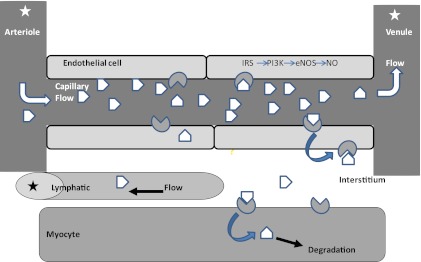FIG. 1.
Insulin (pentagons) enters the skeletal muscle capillary microvasculature where it can exchange between the plasma and the interstitium. This can be assessed by sampling A/V insulin and quantifying blood flow (white stars) or by sampling lymphatic insulin (black star). Alternatively, a microdialysis catheter introduced into muscle is used for sampling (a typical catheter is ∼30× larger than the capillary displayed). Plasma insulin concentrations both fasting and during steady-state hyperinsulinemia are estimated two- to threefold higher than interstitial. Insulin transits to the interstitium from plasma by binding with the insulin receptor on the endothelial cell, activating a signaling cascade that increases nitric oxide (NO) formation. Insulin crosses the vascular endothelium by a vesicular transport pathway and accesses the interstitium where most is removed by muscle through receptor-mediated endocytosis and subsequent degradation. Small amounts of insulin return via lymphatic drainage because flow through the muscle lymphatic system is only approximately 1/100th that of blood flow to muscle. eNOS, endothelial nitric oxide synthase; IRS, insulin receptor substrate; PI3K, 1-phosphatidylinositol 3-kinase.

